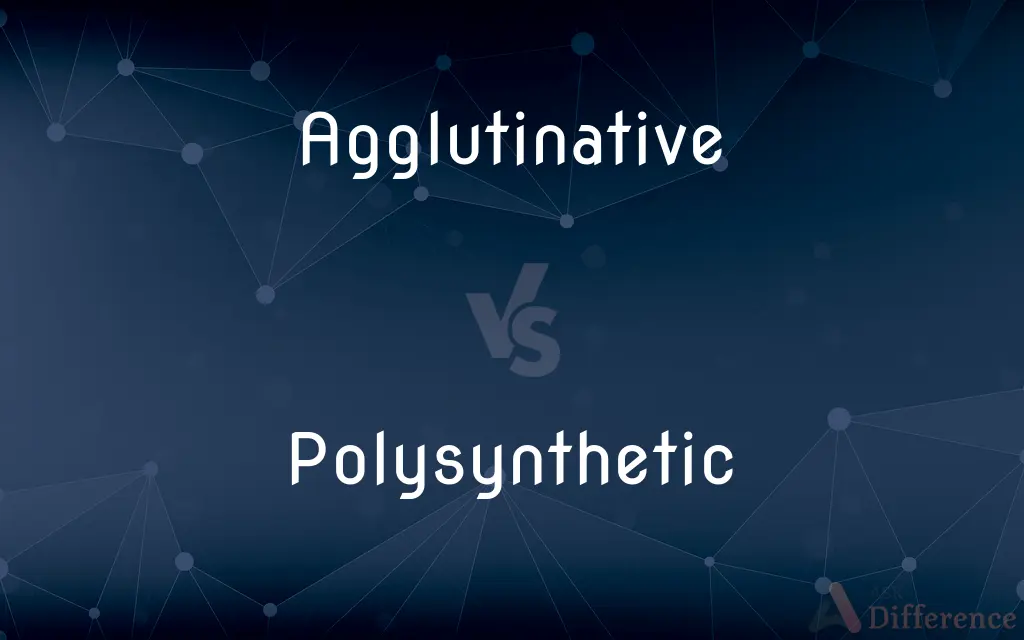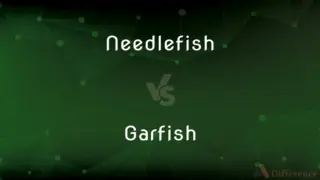Agglutinative vs. Polysynthetic — What's the Difference?
By Fiza Rafique & Urooj Arif — Updated on May 4, 2024
Agglutinative languages affix morphemes to words without changing their structure, while polysynthetic languages often combine multiple morphemes and roots into single, complex words.

Difference Between Agglutinative and Polysynthetic
Table of Contents
ADVERTISEMENT
Key Differences
Agglutinative languages are characterized by their use of affixes that are clearly separable and consistently used, attaching to base words in a predictable manner. In contrast, polysynthetic languages not only use multiple affixes but can also incorporate several roots into single, complex words, reflecting entire phrases or sentences.
In agglutinative languages, each affix typically represents one grammatical category, such as tense or number, and remains unchanged regardless of other elements in the word. On the other hand, polysynthetic languages may modify or blend affixes and roots depending on specific syntactic or phonological contexts.
While agglutinative languages like Turkish or Swahili maintain a relatively straightforward morphological structure, polysynthetic languages, such as Inuktitut or Mohawk, display a high degree of synthesis, incorporating subjects, objects, and verbs into comprehensive verbal complexes.
Agglutinative languages often demonstrate a clear and regular pattern of affixation, making them somewhat easier to segment and analyze linguistically. Conversely, the synthesis in polysynthetic languages can create words so complex that they function as full sentences, making linguistic analysis more challenging.
The morphological richness of polysynthetic languages allows for a vast array of expressions within a single word, potentially conveying subtleties that in other languages might require a full sentence. Whereas, agglutinative languages, while also morphologically rich, tend to express these elements in a more linear and segmented fashion.
ADVERTISEMENT
Comparison Chart
Morpheme Use
Affixes added to base words without altering their structure
Multiple affixes and roots combined into complex words
Grammatical Expression
Each affix represents a single grammatical function
Multiple grammatical functions integrated into single words
Complexity
Moderate complexity with clear affix boundaries
High complexity with integrated morphological structures
Example Languages
Turkish, Swahili
Inuktitut, Mohawk
Linguistic Analysis
Easier to segment and analyze
More challenging due to complex word structures
Compare with Definitions
Agglutinative
Characterized by a clear distinction between root words and affixes.
Swahili uses agglutination to express various grammatical aspects in a transparent manner.
Polysynthetic
Characterized by the integration of multiple grammatical components within words.
Polysynthetic languages often embed subjects, objects, and verbs within a single verbal complex.
Agglutinative
Languages where each morpheme carries only one grammatical meaning.
In agglutinative languages, prefixes and suffixes stack neatly, like building blocks.
Polysynthetic
Pertaining to languages that incorporate several roots and affixes into complex single words.
In Mohawk, entire sentences may be expressed by one polysynthetic word.
Agglutinative
Relating to the methodical layering of prefixes and suffixes.
Agglutinative languages allow for a high degree of precision in expression through multiple affixes.
Polysynthetic
Demonstrating high morphological synthesis, suitable for conveying detailed information compactly.
The polysynthetic nature of Inuktitut allows for expressive and nuanced verbal constructions.
Agglutinative
Pertaining to languages that form words by joining morphemes together without altering them.
In Turkish, the word evlerinizden (from your houses) is formed by straightforwardly adding each morpheme.
Polysynthetic
Languages where words are highly inflected and capable of expressing complete thoughts.
Polysynthetic words can sometimes stand alone as complete utterances, demonstrating their linguistic efficiency.
Agglutinative
Having a grammatical structure primarily formed through the addition of affixes.
Agglutinative languages often display remarkable regularity in verb conjugation.
Polysynthetic
Relating to the dense packing of morphological elements.
Polysynthetic words are linguistically dense, containing layers of intertwined morphemes.
Agglutinative
The act or process of agglutinating; adhesion of distinct parts.
Polysynthetic
Of or relating to a language such as Inuktitut or Mohawk, characterized by long, morphologically complex words with a large number of affixes that express syntactic relationships and meanings usually expressed as phrases or sentences in other languages.
Agglutinative
A clumped mass of material formed by agglutination. Also called agglutinate.
Polysynthetic
Characterized by a prevalence of relatively long words containing a large number of morphemes. Typically, the morphemes are bound.
Agglutinative
(Biology) The clumping together of cells or particles, especially bacteria or red blood cells, usually in the presence of a specific antibody or other substance.
Polysynthetic
(mineralogy) Having layers of twin crystals
Agglutinative
(Linguistics) The formation of words from morphemes that retain their original forms and meanings with little change during the combination process.
Polysynthetic
Characterized by polysynthesis; agglutinative.
Agglutinative
Sticky, tacky, adhesive.
Polysynthetic
Forming derivative or compound words by putting together constituents each of which expresses a single definite meaning
Agglutinative
(grammar) Having words derived by combining parts, each with a separate meaning.
Agglutinative
A sticky material; an adhesive.
Agglutinative
(grammar) A word formed from the combination of parts, each with a separate meaning.
Agglutinative
Pertaining to agglutination; tending to unite, or having power to cause adhesion; adhesive.
Agglutinative
Formed or characterized by agglutination, as a language or a compound.
In agglutinative languages the union of words may be compared to mechanical compounds, in inflective languages to chemical compounds.
Cf. man-kind, heir-loom, war-like, which are agglutinative compounds. The Finnish, Hungarian, Turkish, the Tamul, etc., are agglutinative languages.
Agglutinative languages preserve the consciousness of their roots.
Agglutinative
Forming derivative or compound words by putting together constituents each of which expresses a single definite meaning
Agglutinative
United as if by glue
Common Curiosities
What defines an agglutinative language?
Agglutinative languages are marked by the addition of affixes to words in a consistent, non-changing form.
Can you provide an example of a polysynthetic language?
Inuktitut and Mohawk are examples of polysynthetic languages.
How do polysynthetic languages differ from agglutinative languages?
Polysynthetic languages incorporate multiple roots and affixes into single words that can express complete thoughts, unlike the more segmented approach of agglutinative languages.
What is a key feature of agglutinative languages?
A key feature is their clear and regular pattern of affixation, where each affix has a specific grammatical meaning.
Why are polysynthetic languages considered complex?
Due to their ability to integrate multiple grammatical functions and morphemes into single, complex words, making linguistic analysis more intricate.
What makes polysynthetic languages unique in terms of expression?
Their structure allows for the compact expression of detailed and nuanced information within single words.
How does word formation in polysynthetic languages compare to other language types?
Word formation in polysynthetic languages is highly synthetic, often incorporating elements that in other languages would appear as separate words.
Can agglutinative languages express complex ideas as efficiently as polysynthetic languages?
While agglutinative languages are efficient in their morphological expression, they generally do not reach the level of syntactic and morphological integration seen in polysynthetic languages.
Are all agglutinative languages similar in structure?
While they share the principle of adding affixes in a non-altering manner, the specifics of affixation and grammar can vary widely.
Is learning a polysynthetic language more difficult than learning an agglutinative language?
Learning a polysynthetic language can be more challenging due to its complex word structures and the integration of various grammatical elements.
Share Your Discovery

Previous Comparison
Needlefish vs. Garfish
Next Comparison
Edifying vs. EducationAuthor Spotlight
Written by
Fiza RafiqueFiza Rafique is a skilled content writer at AskDifference.com, where she meticulously refines and enhances written pieces. Drawing from her vast editorial expertise, Fiza ensures clarity, accuracy, and precision in every article. Passionate about language, she continually seeks to elevate the quality of content for readers worldwide.
Co-written by
Urooj ArifUrooj is a skilled content writer at Ask Difference, known for her exceptional ability to simplify complex topics into engaging and informative content. With a passion for research and a flair for clear, concise writing, she consistently delivers articles that resonate with our diverse audience.
















































